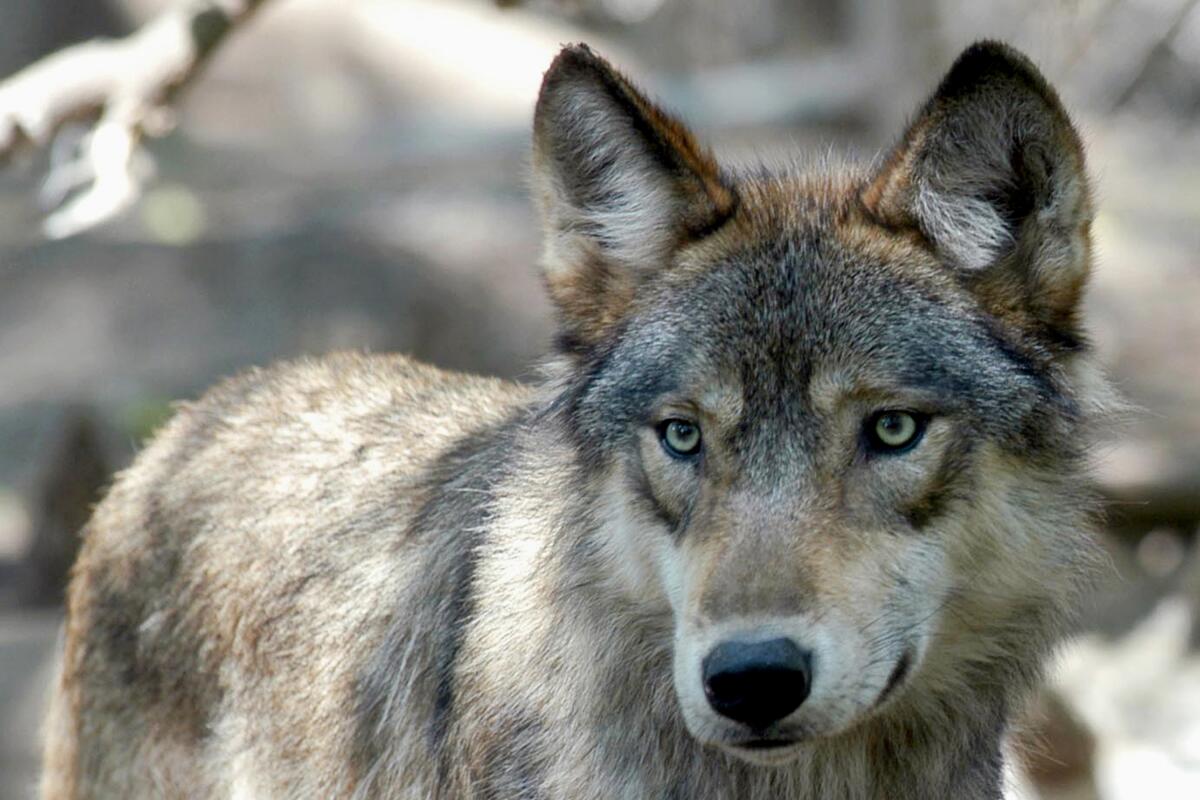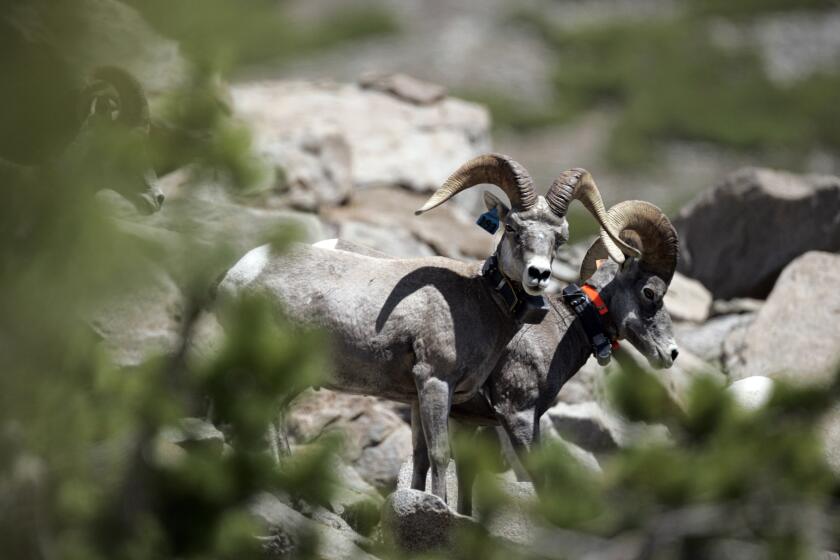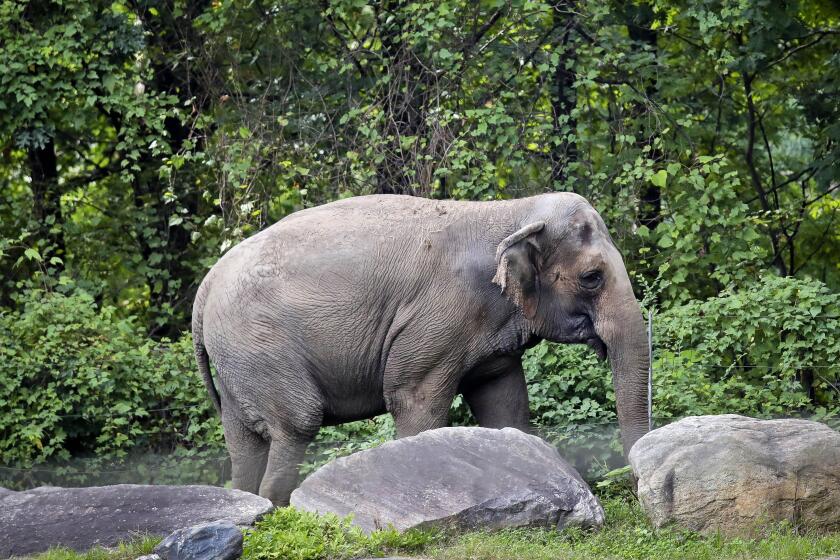Wolves are back in Colorado’s wilderness. Here’s why that’s great for Earth

- Share via
STEAMBOAT SPRINGS, Colo. — Rural western Colorado rang in the new year with a howl.
For the first time in U.S. history, a federally listed endangered species has been reintroduced to the wild by the efforts of a lone state. Wolves in Colorado were not a mandate from Washington, D.C.; Coloradans voted for them.
One week before Christmas, gray wolves were unleashed on a Rocky Mountain mosaic of public lands, pine and aspen forests, private ranches and beloved recreation areas. Wolves now roam within the realm of world-famous ski areas. Some have already wandered through the creeks, peaks and woods near my cabin at the rural edge of Steamboat Springs, where rugged watersheds pour into the Yampa River’s wide-open valley, flowing downstream from the Flat Tops Wilderness past cattle ranches, hay meadows, the towering Steamboat Ski Resort and historic downtown ski jumps.
In the 2020 general election, a slim margin of Coloradans — 50.91% — voted to reintroduce gray wolves to our ecosystem, back to a landscape from which they were exterminated nearly 80 years ago. Thirteen of 64 counties, mostly along the urban Front Range corridor east of the Continental Divide, were definitively supportive. But in the habitat where wolves will reside on Colorado’s less populated, agricultural/recreational Western Slope, the “yes” vote was not as resounding.
This endangered California species has survived ice ages, livestock disease and climate change. The greatest threat to it today may be a once-scarce predator.
Proposition 114 mandated a plan that would reintroduce wolves no later than Dec. 31, 2023. Thirteen days before that deadline, a small group of trucks climbed winding dirt roads through a remote corner of rural Grand County in northwest Colorado. The convoy’s destination: a sliver of state-owned land surrounded by millions of acres of national forest.
Gathering quietly were Gov. Jared Polis, First Gentleman Marlon Reis, a devoted Colorado Parks and Wildlife team and a few influential folks who helped bring about this effort. There was snow on the ground, but nothing daunting.
“It was so perfect. You could look around, and it felt like at any moment John Denver was going to show up. It was ‘Rocky Mountain High’ in every direction,” said Joanna Lambert, a wildlife ecology and conservation biology professor at University of Colorado Boulder and director of the American Canid Project. The stars rolled up last: five wolves, silent in their crates but omnipotent in the waft of their musky aroma. It smelled like the wild, Lambert observed.
One at a time, crate doors were sprung, and powerful hind legs pushed off back walls to crash through the silence. Three grays and two blacks individually bolted into the forest.
If the birds live through winters with more severe storms, the tree cavities where they nest may still be buried under snow in the spring, preventing breeding.
This is a moment of pride for Colorado. Putting paws on the ground was a grassroots effort negotiated in the flames of conflict, compromise and invention. Within a week of the first release, another five wolves, exported from wild packs in Oregon, made their way onto Colorado’s Western Slope, all mature enough to hunt prey on their own.
Wolves maintain an outsize place in the collective imagination. They possess an unusual power to spark deep positive and negative beliefs. Ironically, decades after government-hired exterminators wiped them out, wolves have transformed into a symbol for anti-government sentiment.
In truth, there is nuance in Coloradans’ hearts and minds about this rewilding effort. With a new predator on the ground, ranchers understandably fear for their livelihoods, but coalitions of ranchers and hunters contributed mightily to crafting the reintroduction plan. In fact, local ranchers say they’ve been preparing for wolves since Yellowstone’s reintroduction 29 years ago. And hunters watching scientific data of elk populations in Idaho know that hunts there are more fruitful than ever.
There’s a petition to release elephants from the Fresno Chaffee Zoo, and Ojai recently became the first U.S. city to recognize legal rights for nonhuman animals. California can lead on this issue.
Earth is suffering a biodiversity crisis, and returning wolves to wild places is a good starting point. Trophic cascade, the effect of an apex predator’s presence improving habitat quality and species viability all the way down the food chain, is a prime motivation for wolf reintroduction. Colorado stands to be a model for what a state can do to repair its ecosystems. It will be a complicated, long-haul effort to turn tame landscapes wild again and build resilience for the future.
“We are still in the hangover era of the ‘frontier,’ ” said range scientist and former ranch manager Matt Barnes. “The last hundred years are the most abnormal periods of all human history in many, many ways, including this minor detail about not having wolves in most of the American West.”
One month into this grand experiment, what a wonder it was to witness the first public GPS collar tracking map. Based on data from the Northern Rockies, elk will provide about 80% of the diet for Colorado wolves. And Colorado has a lot of elk, so wolves are unlikely to damage the elk hunt. Wolves aren’t likely to fundamentally change ranching, either, because it is transforming for other reasons — such as rotational grazing, cross fencing and virtual fencing so you no longer have to scatter your cattle over 10,000 acres.
Change is hard. But look what it can spark. The next likely candidate in Colorado’s rewilding effort is the wolverine, the world’s largest terrestrial weasel, which was federally listed as threatened under the Endangered Species Act in November 2023.
A bipartisan wolverine reintroduction bill is expected to be introduced in the Colorado state Legislature during the current session, which started Jan. 10. Changing times on a changing planet.
Jennie Lay is a writer based in Routt County, Colo., and director of the Literary Sojourn festival of authors in Steamboat Springs. @mermaidonthemountain
More to Read
A cure for the common opinion
Get thought-provoking perspectives with our weekly newsletter.
You may occasionally receive promotional content from the Los Angeles Times.












